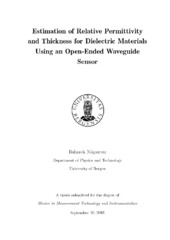| dc.description.abstract | The main goal of this thesis has been to conduct a feasibility study on an open-ended waveguide sensor as a tool for estimating the relative permittivity and thickness of dielectric layers in the thickness range 0.5-5 cm. To achieve this purpose, a reflection coefficient measurement technique was implemented. This non-destructive technique can be a potential method for characterization and configuration of gas hydrate deposition in oil and gas production. Microwaves which are emitted from a network analyzer, propagate through a waveguide sensor, interact with the dielectric material in front of the waveguide, and reflect back. Material and physical properties of the dielectric Material Under Test (MUT), particularly its relative permittivity and thickness, affect the reflected signal. These two parameters can therefore be estimated from the measured reflection coefficient. Calibration of the measurement results was performed using a COMSOL simulation model of the experimental setup. By doing so, the measured reflection coefficients were transformed to the calibrated (transformed) reflection coefficients through a bilinear transformation formula. The COMSOL simulation model was also used to generate permittivity and thickness lookup matrices. The transformed reflection coefficient at different frequencies was mapped to the matrices to estimate the relative permittivity and thickness of the dielectric MUT. To verify the relative permittivity estimation method, the reflection coefficient for three MUTs, ethanol/water mixtures with 0.36, 0.54, and 0.76 molar fractions, was measured in the frequency range 0.5-10 GHz and for a thickness of 3 cm. The measured reflection coefficients were converted to the transformed reflection coefficients. Then, using the permittivity lookup matrix and the transformed reflection coefficients, the relative permittivity was estimated for each fluid in the frequency range 4-10 GHz. In the range 4-6 GHz, the estimation method provided satisfactory results with an estimation error of 20.21%, 11.37%, and 3.80% for the three fluids, respectively. However, in the range 6-10 GHz, the results were not acceptable mainly due to interference between the dominant propagation mode and higher order modes in the waveguide. Additionally, the reflection coefficient was measured for the above mentioned mixtures in the thickness range 0.5-3 cm. The thickness was estimated using the thickness lookup matrix. For thin layers up to 1 cm, there was a good agreement between the estimated and actual thickness values with an estimation error around 20%; whereas, for layers thicker than 1 cm, the error was more than 50%. It was found that the maximum detectable thickness was inversely proportional to the loss factor of the MUT. In case of MUTs with high loss factors, the estimation procedure gave acceptable results only for layers up to 1 cm. By contrast, for low-loss fluids such as diesel, it was found that the method provided satisfactory results for the thickness values up to 5 cm. The mean value of the thickness estimation error for diesel was found to be 6.37% in the range 0.5-5 cm. | en_US |
